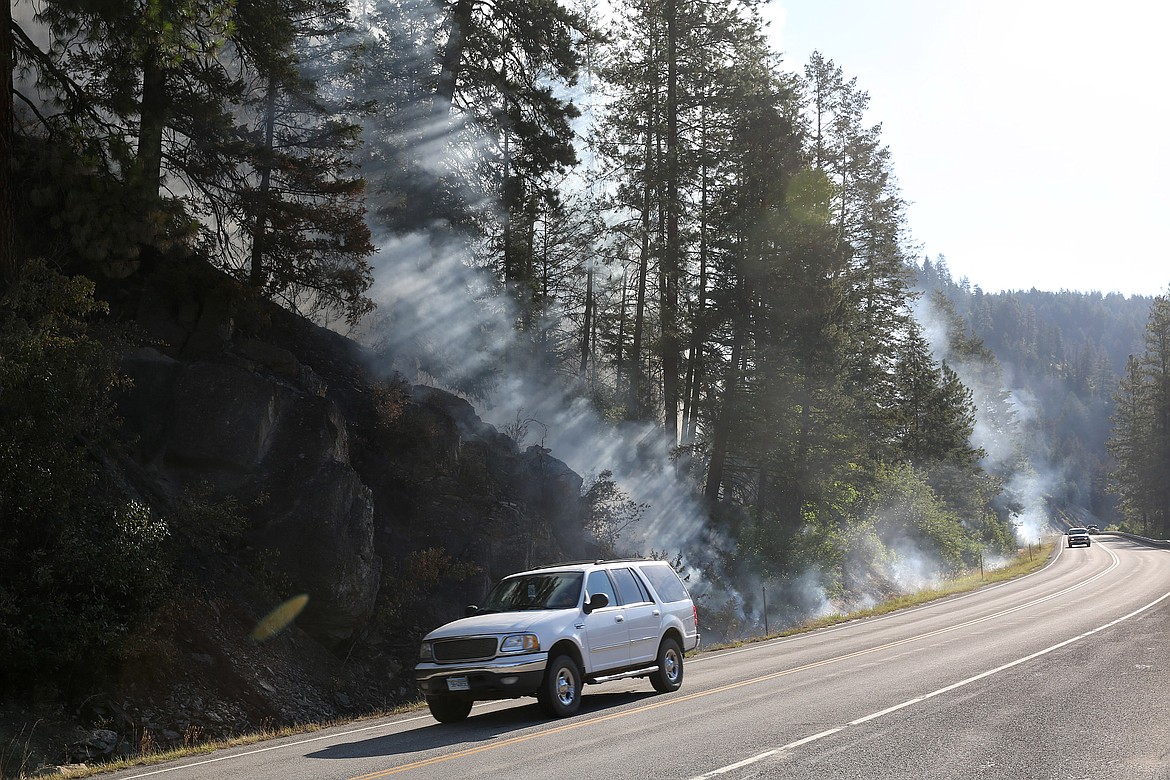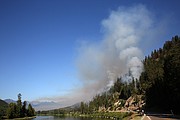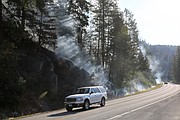Public so far not at risk of asbestos exposure, but some firefighters might be
Despite its proximity to the former W.R. Grace mine, the Highway 37 fire hasn’t come close enough to raise a public health alarm, Lincoln County and Environmental Protection Agency officials say — but it has reached an area where the Forest Service is concerned for the health of firefighters.
The difference, officials say, reflects the distinct responsibilities of the EPA and the Forest Service and is based on activity-based studies.
“Just because there’s asbestos there, how you interact with it is very important [in determining exposure risk],” said Christina Progess, an EPA project manager.
Public health
The area that concerns the EPA and local health officials is Operable Unit 3 (OU3) of the Libby Asbestos Superfund site, which comprises about 10,000 acres that include the former mine.
OU3 measured about 35,000 acres until the EPA completed a human health risk assessment in late 2015.
The assessment showed that “logging, firefighting and recreational uses such as hiking and ATV riding did not pose an unacceptable health risk from a lifetime of exposure outside the current 10,000 acres,” Progess said.
Refining an area of concern as new data becomes available is “typical of any Superfund site,” Progess said, and “necessary to reflect reality, and to not over-exaggerate the concern or to unduly limit activities in the area.”
Progess said the EPA also has data from controlled field and lab tests showing that, when asbestos-contaminated bark and duff burn, most asbestos fibers stay in the ash rather than go up in smoke.
She said the EPA doesn’t have data from a significant wildfire in OU3 because there hasn’t been one, and that for the past two years, the EPA and state and local stakeholders have been working on a plan to monitor and evaluate airborne asbestos concentrations for when a fire does occur.
“We’re not collecting any asbestos data right now,” Progess said.
The fire reaching the OU3 boundary would be the “trigger point” for the Lincoln County Health Department to begin testing the air in Libby and near the fire.
Until then, county health officials say there has been no indication, based on the best available data, of a risk to public health as a result of the Highway 37 fire.
“We know that the activities that the public are doing in town are not on that list of high-risk activities,” said Public Health Manager Jennifer McCully. “And we’re not in the area in which it is deemed important to monitor.”
Noah Pyle, manager of the county’s Asbestos Resource Program, said “a boundary line has to be set somewhere.”
“Someone has to determine where that boundary is, and we made our determination based off the EPA’s data,” he said.
That the county would test the air if fire reaches OU3 doesn’t mean officials know there will be an issue, McCully said.
Testing would be “a check to see if anything’s happening that we need to be concerned about,” Pyle said.
There are three testing stations, one in Libby and two near OU3. Testing lasts for 24 hours, after which the sampling cassettes are sent to a lab via FedEx. Results are expected within 48 hours of shipping, Pyle said.
In addition to its asbestos monitoring plans for an OU3 fire, the county continually monitors particulate matter in the air in the Libby area and will make public health recommendations based on state guidelines as needed, according to a news release McCully issued late last week.
Firefighter health
Surrounding OU3 is what the Forest Service refers to as a modified response zone, an additional area of about 18,000 acres in which fighting fires requires special equipment, training and decontamination.
The zone has no bearing on public safety and was made independent of the EPA, said Pamela Baltz, an environmental engineer with the Forest Service.
Firefighters performing certain activities in the zone — primarily in the ash — must wear respirators and stay in them for no more than eight hours at a time, Baltz said.
“We know that from past data there’s asbestos in the duff in that area, and because the asbestos concentrates in the ash we want to take extra precaution for our employees until we have further data,” Baltz said.
So far the Forest Service has dedicated one 10-person contract crew to respond to fires within the modified response zone. After each shift, the firefighters and their equipment undergo a series of decontaminating showers inside a trailer the EPA paid for.
The Forest Service awaits data from a quarter-acre prescribed burn it conducted inside the zone in May that it hopes will better show the risks firefighters face and help guide the agency’s future firefighting decisions, Baltz said.
Meanwhile, the agency isn’t testing or monitoring the air during the Highway 37 fire, she said, due to the fire’s uncontrolled nature and the need to focus on fighting it.
Testing firefighters’ activity-based exposure is particularly intensive, requiring methodology and personnel that could disrupt firefighting efforts and produce inaccurate results.
“We discussed doing air sampling during a fire, but it’s already a busy time,” Baltz said. “So what we are looking to do in the future is do testing during [additional] prescribed burns, where we can have more control over what’s happening.”
Next steps
As the EPA and the Forest Service continue to collect data in future studies, Progess said the county can use the information “to make health-based decisions about both asbestos and smoke particles” for residents of Libby and elsewhere in Lincoln County.
The data could also once again change the OU3 boundary, Progess said.
“I think that we feel pretty good about the location we have it in now,” she said.





